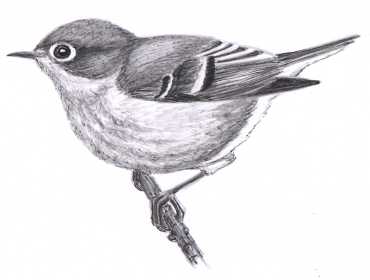
Dear Bird Folks:
I live in the woods of Wellfleet and lately I have been seeing birds in my trees which are very small and very active. I would love to describe these birds to you, but they are too bland to describe. I can’t find any color or other field marks on them except that they are very small, dull, busy birds. Any idea what they are?
Joan, Wellfleet
Really Joan,
You really live in the woods of Wellfleet? Looks like the housing shortage has hit you too. For your sake I hope it’s a mild winter. As for what kind of birds you have Joan, it’s easy, you have given an excellent description of kinglets, probably ruby-crowned kinglets. Just as you said, kinglets are small, dull, busy birds.
Ruby-crowned kinglets are extremely diminutive birds. (That’s right, diminutive. It means wicked small. Look it up, I had to.) In fact, kinglets are smaller than chickadees, wrens and even some of our hummingbirds. And dull? Their drab olive color makes these birds duller than C-SPAN. The ruby-crowned kinglet does have a bit of red running down the middle of its head, but only the male has that and he mostly keeps it hidden. Mating season is about the only time he flashes the red. And even then he looks more like a confused punk rocker with a Mohawk than a flashy bird.
What kinglets lack in color and size, they make up for with energy. These guys are espresso on speed, they never calm down. Kinglets have so much energy that even when they aren’t flying their wings are flicking open and close. If they went to public schools their parents would be buying Ritalin by the case.
Their high energy is not without purpose as it helps them find the food they need to survive cold winters. Kinglets are insect eaters, yet they spend the winter in an area where few other insect eaters can survive. Kinglets spend most of their daylight hours climbing on, and over and around the smallest branches of trees looking for food; food so small most other birds don’t want it or can’t find it. Kinglets survive the winter on minute mites, spiders and plant lice eggs. That’s right, they eat plant lice eggs. Can you imagine? Plant lice are pretty darn small. I wonder how small their eggs must be. They can’t make much of a meal. Yet the little kinglet’s energetic personality is perfect for endlessly searching for the tiniest bits of food.
Ruby-crowned kinglets don’t nest here on Cape Cod, they much prefer the wilds of Canada where there is plenty of spruce trees and their money is worth more. It is on the breeding grounds that we get to hear the kinglets most impressive feature, their song. For such a tiny bird, kinglets have a ridiculously loud song. The call, consisting of short bursts of notes, is so loud and rich that it can be heard at great distances. Many first time observers are fooled into searching for a much larger bird, only to be surprised to find the insect-sized kinglet singing away. The Carolina wren surprises people around here with its loud, raucous call and its small size. Well, the ruby-crowned kinglet is only a third the size of our wren and nearly as loud.
Kinglets are not real regular at bird feeders, but will sometimes take some suet when things get tough. They are most often seen on the Cape during their spring and fall migration, while a few try to tough out our winter.
Maybe you’ll be lucky Joan and have kinglets around all winter. It is thought that to survive cold nights, they hunker down in a tree cavity or thicket with other kinglets, sharing body heat for warmth. That is something I’m sure you must have to do too, living in the woods of Wellfleet.